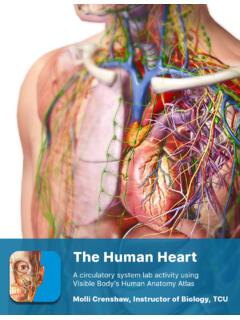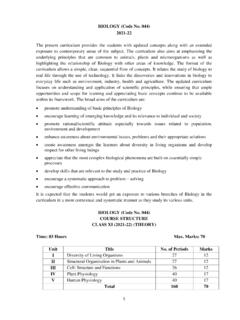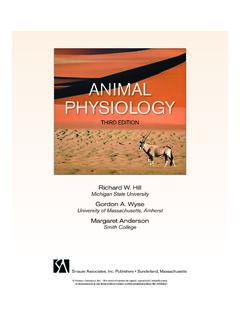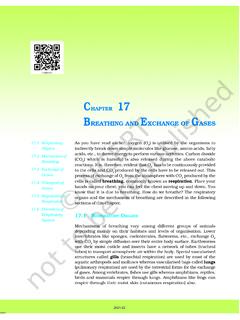Transcription of PRE-LAB EXERCISES
1 12 PRE-LAB EXERCISESOpen the A&P app, and from the left-side menu, select Cells and the modules to guide your exploration of the structure and function of cells. Be sure to use the book icon to learn more about the cellular features that you are exploring. You are responsible for the identification of all bold terms and all answers to the Cell Functions & TypesWatch the video in Module Cells and Tissue Overview, explore the 3D anatomical view in Module Cell Functions, examine the illustration in Module Cell Types, and then answer the following Cells and Tissue Overview3 Skin cells protect organsSex cells enable reproductionMuscle cells move the bodyBlood cells carry oxygenNerve cells transmit signalsBone cells support boneModule Cell Functions41.
2 All living things are composed of one or more cells. Adult humans are composed of trillions of cells that have a stunning array of forms and functions. How many different types of cells are there in the human body?Module Cell Types52. What are six examples of human cell types and their essential functions?ExampleEssential function3. In Module Cell Types, examine the illustrations of six specific cells: a neuron, red blood cell, osteocyte, skeletal muscle cell, sperm cell, and egg cell. a. What observations can you make on how these cells are similar?6b. What observations can you make on how these cells are different?c. What is a difference between a somatic cell and a sex cell? 4. Think about a living organism ( bacterium, fern, fruit fly, or mouse) and consider what characteristics it has that make it alive.
3 What do all living things require and what do they do? Because all living things are composed of one or more cells, cells share some of these characteristics. Write down some characteristics of living these characteristics in mind as you learn about organelles and metabolism in the following in-lab EXERCISES . 7IN-LAB EXERCISESUse the following modules in Visible Body s Anatomy & Physiology app to guide your exploration of cellular structures and their functions. Be sure to select the book icon under the structure name to read information specific to that structure. You are responsible for the identification of all bold terms and all answers to the to the Cells and Tissue unit and select chapter 2 Cell Structure and Cell Parts and the Plasma MembraneExplore the 3D anatomical views in Modules Parts of a Cell and Plasma Membrane and examine the illustration in Module Structure of the Plasma Membrane to learn about three major cellular structures.
4 Use these modules to answer the following bilayerCytoplasmOrganellesCytosolPlasma membraneNucleusModules Parts of a Cell and Plasma Membrane 8 Plasma membraneNucleusCytoplasm1. In the following diagram, label the major cellular structures: the nucleus, cytoplasm, and plasma Structure of the Plasma Membrane92. Although most cells have the three structures labeled in the previous diagram, there are some rare exceptions. What is an example of a type of cell that is missing one of these structures, and what structure is it? 3. The outer membrane of a cell (plasma membrane) and all the membranes found within a cell are built largely of phospholipids that are organized in a bilayer. For your reference, a simplified diagram of a phospholipid is provided below.
5 In the following space, carefully draw a phospholipid bilayer that contains approximately twelve phospholipids. Then, label a hydrophilic phospholipid polar head and a hydrophobic phospholipid fatty acid tail. Finally, draw and label some membrane proteins. 4. Phospholipids in an aqeous (water) solution may spontaneously form bilayers. Why will they spontaneously form these structures? 5. Proteins are found in and around a lipid bilayer. What are some functions of these proteins?10B. Transport and OsmosisWatch the video in Module Passive and Active Transport, explore the 3D anatomical view in Module Transport Vesicles, and examine the illustration in Module Osmosis to learn about principles of cellular transport.
6 Use these modules to answer the following questions. Module Passive and Active TransportPlasma membraneTransport vesiclesModule Transport Vesicles111. Moving substances from an area of low concentration to an area of high concentration is not energetically favorable. How do cells move substances that are of low concentration on one side of a cell membrane to the other side, where they are relatively high?2. Some substances are transported within the cell, or across membranes, within membranous sacs. What are these structures called?3. In the following illustration, draw an arrow to show the direction of osmosis. The large circles represent cells and the black dots represent molecules of solute, or the substance dissolved in water.
7 Is water flowing into or out of each type of cell? Note: In one context, water will not move into or out of the Osmosis12C. cellular Organelles and Their FunctionsExplore the 3D anatomical views in the following modules that identify cellular organelles and describe their function: Organelles, Cytoskeleton and Centrosome, Endoplasmic Reticulum, Golgi Complex, Lysosomes and Peroxisomes, and Nucleus, Mitochondria and Ribosomes. Use these modules to answer the following each of the following functions, identify the type of organelle that performs Cytoskeleton B. CentrosomeC. Rough endoplasmic reticulumD. Smooth endoplasmic reticulum E. Golgi complexF. PeroxisomeG. LysosomeH. NucleusI. NucleolusJ.
8 RibosomeK. Mitochondrion (pl. mitochondria)1. A relatively small organelle that contains enzymes that oxidize organic substances _____2. Composed of RNA and protein, this organelle synthesizes proteins _____3. An organelle that uses oxygen to produce ATP _____4. A network of protein filaments that extend throughout the cytoplasm _____5. A large organelle that contains genomic DNA _____6. Found in the nucleus, this organelle contains DNA, RNA, and protein _____7. An organelle that contains centrioles, which are composed of microtubules, and pericentriolar material with protein complexes that play a critical role during cell division _____8. A relatively small organelle that contains hydrolases that break down worn out parts of the cell _____9.
9 A membranous organelle that modifies proteins and packages them in transport vesicles _____10. A network of tubules that synthesize and transport materials needed for cellular growth and other functions _____11. A membranous organelle that is covered in ribosomes _____13D. cellular RespirationExamine the illustration in Module cellular respiration Definition, watch the video in Module cellular respiration , and then answer the following questions on cellular cellular respiration DefinitionModule cellular Respiration141. What are the three steps of cellular respiration and where do they occur?2. When all three steps of cellular respiration occur, how many ATP molecules can be produced for each molecule of glucose?
10 E. TranscriptionExamine the illustration in Module Transcription Definition, watch the video in Module Transcription, and then answer the following questions on Transcription Definition151. What is messenger RNA (mRNA)?2. Where does mRNA get transported, so that it may be used to synthesize protein? Module Transcription16F. TranslationExamine the illustrations in Modules Translation Definition and Codons and the Ribosome, watch the video in Module Translation, and then answer the following questions on Translation Definition17 Module Codons and the RibosomeModule Translation18 Read through the following steps of translation and place them in the correct order by numbering them 1 8. 1. _____ A small ribosomal subunit binds to an mRNA and the first tRNA at the start _____ A stop codon is encountered on the mRNA, which signals that protein synthesis is _____ The large ribosomal subunit joins the small subunit, mRNA, and tRNA complex, and a fully functional ribosome is _____ The finished protein is released and the ribosomal subunits _____ mRNA leaves the nucleus and enters the _____ The ribosome binds to a second tRNA with the proper anticodon.






